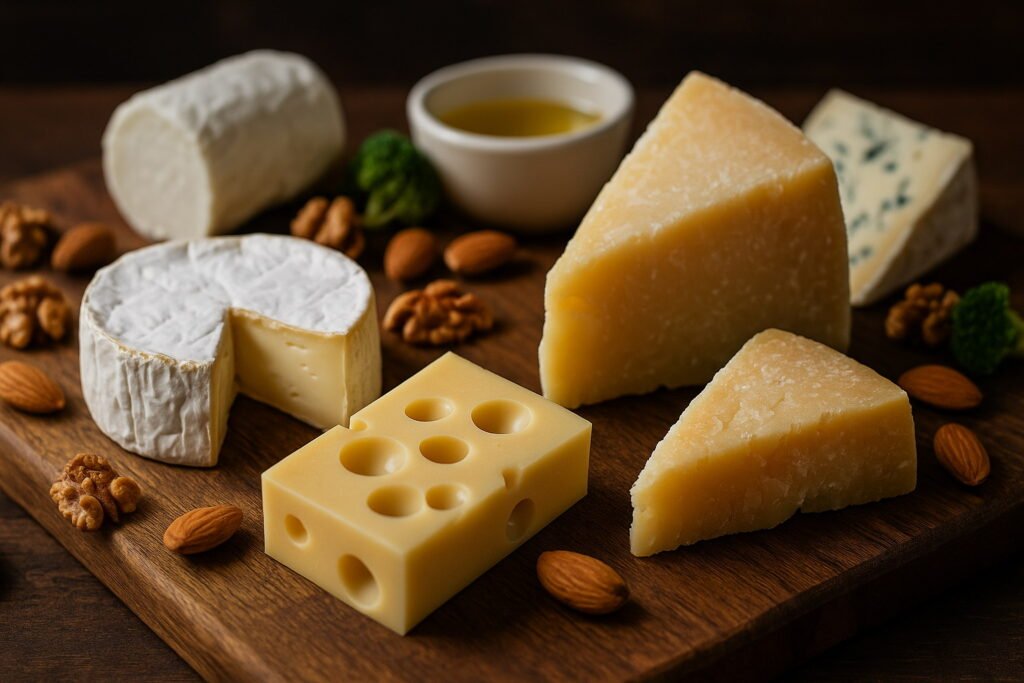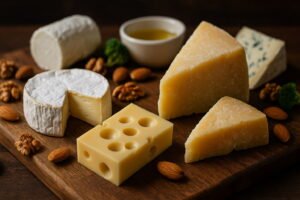For anyone embracing the Paleo lifestyle, the question “Can I eat cheese on a Paleo diet?” often sparks curiosity—and sometimes confusion. The Paleo diet, built around the foods our hunter-gatherer ancestors once ate, emphasizes whole, natural, and unprocessed foods. That means fresh vegetables, fruits, nuts, seeds, and high-quality meats. Dairy, including cheese, didn’t exist during the Paleolithic era, which makes it a gray area in this modern ancestral eating plan.
Yet, cheese remains one of the most tempting foods for those transitioning to Paleo. It’s creamy, flavorful, and rich in nutrients like calcium and protein. But does it truly belong in a Paleo kitchen—or should it be left behind with modern processed foods? Let’s explore what science and the Paleo philosophy say about cheese, and whether certain types might still fit your clean-eating goals.
In This Article
Understanding the Paleo Diet Philosophy
The Paleo diet, often called the “caveman diet” or “ancestral diet,” is more than just a trend—it’s a return to simplicity. The core idea is to eat the way early humans did before the rise of agriculture and food processing. That means consuming foods that are as close to their natural state as possible.
Here’s what’s typically included and excluded on the Paleo diet:
| Paleo-Approved Foods | Non-Paleo Foods |
| Grass-fed meats, fish, and poultry | Dairy (milk, cheese, butter) |
| Vegetables and fruits | Grains (wheat, rice, oats) |
| Nuts and seeds | Legumes (beans, peanuts, lentils) |
| Eggs | Refined sugar and processed oils |
| Healthy fats (olive oil, avocado, coconut) | Processed or packaged foods |
The exclusion of dairy is not arbitrary—it’s based on evolutionary reasoning. Humans didn’t domesticate animals or consume milk until about 10,000 years ago. That’s a blink in evolutionary time, meaning our bodies may not be fully adapted to digest dairy efficiently.
In short, cheese isn’t traditionally Paleo because it’s a processed dairy product made from milk, enzymes, and often salt. However, like many aspects of modern nutrition, the reality isn’t strictly black and white. Some people following a “Primal” or modified Paleo diet find certain cheeses compatible with their body and lifestyle.
Why Cheese Is Controversial on the Paleo Diet
Cheese is one of the most debated foods in the Paleo community. While some see it as a nutrient-rich, fermented product with potential benefits, others view it as an inflammatory dairy source that contradicts the essence of Paleo eating.
Let’s break down the main reasons behind the controversy:
1. Evolutionary Inconsistency
Our Paleolithic ancestors didn’t have access to domesticated animals, meaning dairy simply wasn’t part of their diet. The Paleo principle argues that we should eat only what humans evolved to digest naturally—thus, cheese doesn’t make the ancestral cut.
2. Lactose Intolerance and Casein Sensitivity
Cheese contains lactose (milk sugar) and casein (milk protein), both of which can cause digestive discomfort or inflammation in some individuals. Around 65% of adults worldwide have reduced ability to digest lactose after infancy. For these people, eating cheese may lead to bloating, cramps, or skin flare-ups—clearly not aligned with the Paleo goal of gut health.
3. Processing and Additives
Modern cheese production often includes pasteurization, preservatives, and industrial enzymes. These steps alter the food’s natural structure, making it far removed from what early humans would have eaten. Even artisanal cheeses, though less processed, are still products of agriculture and fermentation technology developed long after the Paleolithic period.
4. Nutritional Paradox
Cheese does offer some health benefits. It’s a good source of calcium, protein, vitamin K2, and beneficial fats. Aged and fermented cheeses can even contain probiotics, which support gut health. However, these benefits must be weighed against potential downsides like inflammation, acidity, and dairy intolerance.
“Cheese can be nutritious, but it’s not inherently Paleo,” explains Dr. Loren Cordain, founder of the Paleo movement. “Our bodies weren’t designed to consume dairy in large amounts. Some may tolerate it, but others will experience inflammation or digestive issues.”
This complexity is what makes the cheese on Paleo diet discussion so fascinating. It’s not simply “allowed” or “forbidden” — it depends on your body, your goals, and how strictly you follow the Paleo principles.
Is Any Cheese Paleo-Friendly?
While traditional Paleo guidelines say no to dairy, modern interpretations—especially the Primal Diet—allow for some flexibility. The truth is, not all cheeses are created equal. The source of the milk, how it’s processed, and whether it’s fermented or raw all play a major role in determining how “Paleo-friendly” a cheese might be.
People who follow a modified Paleo diet or a Primal lifestyle sometimes include certain types of cheese, particularly when these meet three key conditions:
- Made from grass-fed milk — Animals raised on natural diets produce more omega-3s and vitamins A, D, and K2.
- Unpasteurized and raw — Raw milk cheese retains beneficial bacteria and enzymes that may aid digestion.
- Aged or fermented — Longer aging reduces lactose, making the cheese easier to digest for most people.
For example, aged Parmesan or raw goat cheese contains very low lactose levels, meaning they are often tolerated even by people with mild dairy sensitivities.
So, while strict Paleo followers avoid cheese altogether, others in the Paleo/Primal community find it acceptable as an occasional treat—especially when it’s raw, natural, and minimally processed.
The Best Types of Cheese for Paleo-Like Diets
If you’re curious to experiment with cheese while staying close to Paleo principles, some varieties are better suited than others. These cheeses are typically lower in lactose, made from grass-fed milk, and less processed.
Here’s a quick overview:
| Cheese Type | Source | Lactose Level | Paleo Compatibility | Notes |
| Goat Cheese (Chèvre) | Goat milk | Low | ★★★★☆ | Easier to digest, rich in MCTs and calcium |
| Sheep’s Milk Cheese (Pecorino, Manchego) | Sheep milk | Low | ★★★★★ | High in protein, often grass-fed |
| Aged Parmesan | Cow milk | Very low | ★★★★☆ | Aged >12 months, minimal lactose |
| Raw Grass-Fed Cheese | Varies | Moderate | ★★★☆☆ | Retains enzymes, probiotics, and nutrients |
| Blue Cheese (Gorgonzola, Roquefort) | Cow/Sheep milk | Low | ★★★☆☆ | Contains beneficial mold cultures |
Key Takeaways:
- Choose aged, raw, or fermented varieties.
- Avoid cheeses that contain fillers, preservatives, or artificial colorings.
- Opt for sheep or goat cheese if you’re sensitive to cow dairy.
While these options aren’t strictly “Paleo,” they can be part of a Paleo-inspired or Primal diet—especially if your body tolerates them well.
How to Choose Paleo-Compatible Cheese
If you’re going to include cheese in your Paleo plan, the goal should be quality over quantity. Here’s how to make sure your choice aligns as closely as possible with Paleo principles:
1. Read the Ingredients
The best cheese should have only three main ingredients: milk, enzymes, and salt. Skip anything with stabilizers, gums, flavorings, or preservatives.
2. Pick Grass-Fed and Organic Sources
Cheese made from grass-fed milk has a superior nutrient profile—higher omega-3 fatty acids, more conjugated linoleic acid (CLA), and better vitamin content. These nutrients are critical in the Paleo approach to whole-body health.
3. Go for Raw or Aged Cheese
Raw, unpasteurized cheese contains beneficial bacteria and active enzymes that can support digestion. Aged cheeses naturally reduce lactose, making them easier to tolerate.
4. Prioritize Traditional and Minimal Processing
Avoid ultra-processed or “cheese products.” Look for artisanal or small-batch cheese makers who use traditional methods.
5. Watch Portion Size
Even high-quality cheese can be calorie-dense and easy to overeat. A thumb-sized portion (about 1 ounce) is typically enough to enjoy flavor without overdoing it.
Quick Checklist for Paleo-Compatible Cheese
| Criteria | What to Look For |
| Source | Grass-fed animals |
| Processing | Raw or traditionally aged |
| Ingredients | Milk, enzymes, salt (nothing more) |
| Lactose Level | Aged = lower lactose |
| Origin | Local, organic, or artisanal |
“If you can find cheese that’s raw, grass-fed, and naturally aged, it’s about as close to Paleo as modern dairy can get,” says Mark Sisson, founder of The Primal Blueprint.
Cheese Alternatives for Strict Paleo Dieters
If you’re following a strict Paleo diet, traditional cheese won’t make the cut. But that doesn’t mean you have to miss out on creamy, cheesy flavors. There’s a growing world of Paleo-friendly cheese alternatives made from natural, whole-food ingredients — and they taste surprisingly good.
Top Paleo Cheese Substitutes
| Cheese Alternative | Main Ingredient | Texture & Taste | How to Use |
| Cashew Cheese | Soaked cashews, lemon juice, nutritional yeast | Creamy, tangy | Great for dips, spreads, and sauces |
| Almond Ricotta | Blanched almonds, olive oil, garlic | Soft, nutty | Perfect for Paleo lasagna or zucchini rolls |
| Coconut Cheese | Coconut milk, agar-agar | Slightly firm, mild | Works well on Paleo pizza |
| Nutritional Yeast | Inactive yeast flakes | Savory, umami flavor | Sprinkle on veggies for cheesy flavor |
| Macadamia “Cheese” | Macadamia nuts, apple cider vinegar | Rich and buttery | Ideal for topping roasted vegetables |
Homemade Paleo “Cheese” Recipe: Cashew Cheese Spread
Ingredients:
- 1 cup raw cashews (soaked overnight)
- 2 tbsp nutritional yeast
- 1 tbsp lemon juice
- ½ tsp sea salt
- ¼ cup water (adjust for thickness)
- Optional: garlic or herbs for flavor
Instructions:
- Drain and rinse the soaked cashews.
- Blend all ingredients in a food processor until smooth and creamy.
- Adjust seasoning to taste.
- Store in an airtight container for up to 5 days.
This plant-based alternative mimics real cheese’s texture while staying true to Paleo values — dairy-free, clean, and nutrient-rich.
Paleo Recipe Ideas with Cheese or Alternatives
Even if cheese isn’t traditionally Paleo, creative recipes can bridge the gap between comfort food and ancestral eating. Whether you choose raw cheese or dairy-free alternatives, here are a few delicious ways to enjoy that creamy flavor while staying Paleo-aligned.
1. Baked Cauliflower “Mac and Cheese”
- Replace macaroni with steamed cauliflower florets.
- Use homemade cashew cheese sauce for a silky texture.
- Bake until golden and bubbly for a cozy, low-carb meal.
2. Paleo Pizza with Almond Flour Crust
- Make a simple crust with almond flour, egg, and olive oil.
- Top with tomato sauce, vegetables, and sheep’s milk cheese or a coconut-based cheese.
- Bake until crisp and aromatic.
3. Zucchini Lasagna with Almond Ricotta
- Slice zucchini into thin ribbons for noodles.
- Layer with almond ricotta, spinach, and grass-fed ground beef.
- Bake for a nutrient-packed, dairy-free comfort dish.
4. Roasted Veggies with Nutritional Yeast
- Toss your favorite vegetables (broccoli, carrots, cauliflower) in olive oil and roast.
- Sprinkle nutritional yeast for a cheesy, umami flavor boost.
These recipes deliver creamy satisfaction without compromising Paleo principles. They also support better digestion and maintain energy balance — two core goals of the Paleo approach.
Health Benefits and Drawbacks of Cheese on a Paleo Diet
The cheese on Paleo diet debate isn’t just about rules — it’s also about how cheese affects your health. Some people thrive when adding small amounts of cheese, while others experience inflammation or discomfort. Let’s take a closer look at both sides.
Potential Health Benefits
- Rich in Nutrients: Cheese provides calcium, phosphorus, zinc, and vitamin B12 — essential for bone and brain health.
- Source of Healthy Fats: Particularly from grass-fed animals, cheese contains beneficial omega-3s and CLA (Conjugated Linoleic Acid), which may help reduce inflammation.
- Probiotics for Gut Health: Aged or raw cheeses like Gouda and Parmesan can contain beneficial bacteria that support digestion.
- High-Quality Protein: Cheese is a compact source of bioavailable protein, supporting muscle growth and satiety.
Possible Drawbacks
- Lactose Intolerance: Most adults lose lactase enzyme activity, making dairy difficult to digest.
- Casein Sensitivity: Some people develop immune reactions to casein, leading to inflammation or acne.
- Calorie Density: Cheese is energy-dense — easy to overeat, especially for those trying to lose weight.
- Modern Processing: Many commercial cheeses contain preservatives and additives that are far from Paleo-friendly.
Case Study: Cheese Tolerance and Individual Variation
A 2021 nutrition survey published in Frontiers in Nutrition found that 30–40% of people following Paleo or Primal diets reintroduced small amounts of aged cheese without negative effects. Those who selected grass-fed, raw, or goat-based cheeses reported fewer digestive issues compared to conventional dairy consumers.
Conclusion:
Cheese can offer valuable nutrients, but tolerance varies widely. The Paleo philosophy encourages listening to your body — if cheese causes discomfort, skip it. If not, enjoy it occasionally and choose the cleanest form possible.
How to Reintroduce Cheese the Paleo Way
If you’ve been following a strict Paleo plan and want to test whether your body can handle cheese, it’s important to do it strategically. Reintroduction should be slow, intentional, and observant. The Paleo diet encourages tuning in to your body’s natural signals, and dairy reintroduction is no different.
Here’s a step-by-step guide to safely reintroducing cheese the Paleo way:
1. Start with the Right Type
Choose the cleanest, least processed cheese available:
- Goat or sheep cheese (easier to digest)
- Aged cheeses (lower in lactose)
- Raw or grass-fed cheese (more nutrients, enzymes)
2. Begin with a Small Serving
Try a small piece (about 1 ounce) on its own. Avoid mixing with other potential irritants such as grains, alcohol, or sugar. This helps you isolate any reaction.
3. Monitor Your Body’s Response
Pay attention to:
- Digestive changes (bloating, gas, cramps)
- Skin reactions (acne, rashes)
- Mood or energy fluctuations
- Nasal congestion or mucus buildup
If symptoms appear, it’s a sign your body isn’t tolerating cheese well.
4. Wait 72 Hours Before Reintroducing Again
It can take up to three days for mild inflammation or intolerance symptoms to appear. Wait before adding more to gauge how your body responds.
5. Document the Process
Keep a simple food journal to note your experiences. Tracking how your body reacts helps you make long-term, informed choices.
Tip: For many Paleo enthusiasts, a “tolerable cheese list” develops over time. You might find that you can enjoy sheep’s milk Pecorino but not cow’s milk cheddar — and that’s perfectly fine. The goal isn’t perfection; it’s awareness.
Frequently Asked Questions About Cheese and the Paleo Diet
Here are some of the most common questions Paleo dieters ask when it comes to cheese.
Is Cheese Allowed on the Paleo Diet?
Technically, no. Cheese is made from dairy, which wasn’t part of the Paleolithic food environment. However, some followers of Primal or Paleo-flex variations include certain high-quality cheeses occasionally, based on individual tolerance.
What’s the Difference Between Paleo and Primal Diets Regarding Cheese?
The Primal Diet, popularized by Mark Sisson, is more flexible. It allows raw, fermented dairy and grass-fed cheese in moderation. The Paleo Diet, as defined by Dr. Loren Cordain, excludes all dairy completely.
In short:
- Paleo: Strictly no dairy.
- Primal: Dairy in moderation, especially raw or fermented.
Which Cheese Is the Least Inflammatory?
Cheeses that are aged, raw, and grass-fed — like Parmesan, Manchego, and raw goat cheese — tend to be less inflammatory. Their lower lactose and casein levels make them easier on the digestive system.
Is Feta Cheese Paleo-Friendly?
Traditional feta (made from sheep or goat milk) is not strictly Paleo, but it’s often accepted in Primal or relaxed Paleo diets due to its high protein and lower lactose content. Always look for authentic, brine-cured, and additive-free varieties.
Can I Eat Mozzarella or Cheddar on Paleo?
Mozzarella and cheddar are non-Paleo, but if you’re experimenting with cheese tolerance, choose organic, grass-fed, aged cheddar or buffalo mozzarella instead of processed varieties.
What About Lactose-Free Cheese?
Lactose-free cheese may reduce digestive issues but doesn’t change the fact that it’s a dairy product. It’s still not considered Paleo, though it can be a gentler option for those easing back into dairy.
Expert Opinions and Research Insights
Experts in the ancestral health field hold mixed opinions about cheese, but most agree that context and quality matter.
Dr. Loren Cordain (Founder of the Paleo Diet)
“Our ancestors did not consume milk or cheese, and most modern humans remain genetically adapted to a dairy-free existence. Cheese is not Paleo—but if someone tolerates it without issues, it’s an individual choice.”
Cordain’s stance reflects the traditional Paleo philosophy: avoid dairy entirely to minimize potential inflammation and digestive stress.
Mark Sisson (The Primal Blueprint)
“Primal eating allows for flexibility. If you tolerate high-quality dairy like raw or fermented cheese, it can be a great addition to your diet for flavor and nutrients.”
Sisson’s Primal approach offers a bridge between Paleo principles and modern practicality — recognizing that not everyone responds to dairy the same way.
Recent Nutrition Research
A 2022 study published in Nutrients found that fermented dairy products like cheese may have neutral or even positive effects on metabolic health, especially when consumed in moderation. The fermentation process can alter dairy proteins and fats, potentially making them more digestible.
This finding aligns with what many modern Paleo practitioners practice — personal adaptation over rigid exclusion.
Summary Table: Paleo Expert Perspectives on Cheese
| Expert / Source | Position on Cheese | Rationale |
| Dr. Loren Cordain | Not Paleo | Dairy was not consumed during Paleolithic era |
| Mark Sisson | Allowed in moderation (Primal) | Focus on raw, fermented, grass-fed options |
| Chris Kresser (Functional Medicine Expert) | Individual choice | Cheese may be fine if no digestive or inflammatory response |
| Scientific Consensus (Recent Studies) | Neutral to positive | Fermented dairy can provide probiotics and nutrients |
Key Takeaway
Modern science and expert opinions both suggest that while cheese isn’t technically Paleo, it doesn’t have to be off-limits for everyone. If you value the Paleo philosophy but also appreciate flexibility, small amounts of high-quality cheese can fit — as long as your body agrees.
Practical Tips for Enjoying Cheese on a Paleo Diet
If you’ve decided that small amounts of cheese fit your personal version of the Paleo diet, the key is to enjoy it intentionally. Here are some practical, evidence-based tips to help you balance taste, nutrition, and ancestral eating principles.
Smart Ways to Incorporate Cheese
- Use as a garnish, not the main ingredient. Sprinkle a small amount on vegetables, eggs, or salads for flavor without overdoing dairy intake.
- Pair with Paleo foods. Combine cheese with whole foods like grass-fed meats, leafy greens, or roasted vegetables.
- Choose quality over quantity. A small slice of raw goat cheese is better than a handful of processed cheddar.
- Buy local and artisanal. Traditional cheesemakers often use grass-fed milk and skip unnecessary additives.
- Freeze small portions. If you buy in bulk, freeze extra cheese to prevent overeating and reduce waste.
Best Times to Eat Cheese
- Post-workout: Cheese provides quick protein and fat for muscle repair.
- With fiber-rich meals: Pairing with veggies helps balance digestion.
- Occasionally: Think of cheese as a luxury ingredient — not a daily staple.
“Cheese can enhance a Paleo meal when used wisely — it’s all about balance, awareness, and quality,” notes nutrition researcher Chris Kresser.
Common Mistakes When Including Cheese in a Paleo Diet
Even health-conscious eaters can misstep when reintroducing cheese. Avoid these pitfalls to maintain the integrity of your Paleo lifestyle:
- Choosing processed cheese. Avoid slices, spreads, or “cheese products.” They often contain emulsifiers, preservatives, and vegetable oils.
- Overeating. Cheese is calorie-dense and can lead to hidden weight gain.
- Ignoring food sensitivities. If you experience bloating, skin issues, or fatigue, dairy might not be right for you.
- Assuming all cheese is the same. Aged, grass-fed cheese is very different nutritionally from mass-produced dairy.
- Using cheese to replace whole foods. Paleo emphasizes nutrient diversity — cheese should complement, not dominate, your meals.
Quick Self-Check: Is Cheese Working for You?
Ask yourself:
- Do I feel bloated or sluggish after eating cheese?
- Does my skin react?
- Am I still meeting my Paleo nutrient goals (protein, fiber, micronutrients)?
If your answers point to discomfort or imbalance, it may be time to scale back or switch to Paleo cheese alternatives like cashew cheese or nutritional yeast.
Conclusion: Making an Informed Choice About Cheese on a Paleo Diet
The cheese on Paleo diet conversation highlights a fundamental truth about nutrition: there is no one-size-fits-all answer. Traditional Paleo guidelines say “no” to dairy, but modern evidence and real-world experiences suggest that some people can enjoy certain cheeses without compromising their health.
If you choose to include cheese:
- Prioritize grass-fed, raw, or aged varieties.
- Consume it in moderation.
- Always listen to your body’s response.
And if you prefer to go strictly dairy-free, you’re still covered with flavorful alternatives like cashew cheese, almond ricotta, and nutritional yeast — all offering satisfying, creamy textures that align perfectly with Paleo values.
In the end, the Paleo lifestyle is about eating intentionally, nourishing your body, and respecting your individual biology. Cheese can be part of that — or not — depending on what feels right for you.
“The best diet is one that honors both ancient wisdom and modern understanding.”
For additional reading, check out Mark’s Daily Apple — a trusted resource on Paleo and Primal nutrition that explores how real food choices affect health and longevity.



